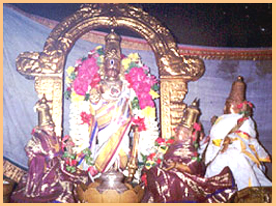
Today we will see Gita from Anbil Kshetram, about 20 miles from Srirangam. This is one of the 40 Chola Kshetrams. Thirumzhisai Alwar has mentioned this Kshetram in one hymn. This is famous for relieving Sri Shiva and Sri Brahma from a curse and similarly sage Mandooka was freed from his curse. The Lord here is Sri Sundararaja Perumal, in a reclining pose with His Consorts ay the feet. Utsavar is called Sri Vadivazhagiya Nambi. Thayar is called Sri Vadivazhagiya Nachiyar and Sri Sundaravalli Thayar. A unique feature is Sri Andal graces the devotees in a sitting posture. Sri Brahma and Sri Shiva meditated here to get their sins relieved. Similarly, Bruhu Rishi once cursed Mandooka Rishi, and he came here to get relief from that curse. Only one poem is there on this Lord by Thirumazhisai Alwar. Just as in Kudanthai [Kumbakonam], Vekha [near Kanchipuram], Evvul [Trivellore], Srirangam, Thiruppernagar [as Appakudathan] and in the Milky Ocean, the Lord blesses the devotees in this Kshetram also in a reclining pose. So admires the Alwar. He is waiting to bless the devotees who seek asylum at His feet. Worshiping the lord is called Deva Pooja, which is Yajna. Yajna, yagam and homam all denote the same that is Deva pooja. As per Sanskrit grammar yaja deva poojayam is the root. So Deva pooja is yaja or yajna. Ordinary persons cannot perform elaborate yajna, but certainly they could do Deva pooja. For this the Lord must be attractive, He must be in our mind and we should have devotion. The Lord here is so beautiful that it becomes a pleasure for us to worship Him. From the 9th to 16th , eight slokas, describe the necessity for Deva pooja. The 9th sloka alone is introduction. Deva pooja is essential to keep this world moving. The second Chapter dealt with the need to practice Karma yoga and reach Gyana yoga and get atman sakshatkaram. In the third Chapter, however, it was told how Karma yoga itself could get atman sakshatkaram. First Chapter was called Arjuna vishada yogam. Second Chapter was named Sankya yogam as it praised Gyana yoga, which could be practiced with sankya or buddhi or intellect. This Chapter is called Karma yogam as it deals with Karma yoga. Sri Krishna told five reasons why Arjuna should practice Karma yoga rather than Gyana yoga:
1. We are all used to Karma yoga right from our birth and in our all previous births and so action of our organs and senses is our habit. Gyana yoga on the other hand is to be specially learnt and practiced. So habitual Karma yoga is easier.
- In Gyana yoga it is expected to control all our senses and organs. Such anticipation is not there in Karma yoga. The limbs are all allowed to do what they can in the service of God and slowly detachment is developed. Therefore, this becomes easier for us to practice Karma yoga.
- In Karma yoga the possibility of slippage from practice is very little. In Gyana yoga slippages are very high. Because, in Karma yoga the organs do their assigned activities, we practice Karma yoga and so the chances of continuation is high. But we saw earlier that a person directly trying to practice Gyana yoga by external control, fails as the mind wanders after the senses and so the objective slips.
- In Karma yoga we use our intellect or gyana. When we perform pooja we know that such activity would get us Moksham. We believe that doing good to others would please Him. Atman is eternal and is different from body. All these basic knowledge are there in a Karma yogi. Vice versa is not true. In Gyana yoga there are no actions or karma.
5. Even for a person practicing Gyana yoga maintainance of his health and body need and so Karma yoga becomes inevitable. But a karma yogi need not do Gyana yoga.
So Karma yoga does not stipulate difficult conditions and becomes easier to follow. It does not greatly disrupt our routines. Arjuna gets a doubt here. When one indulges in activities while practicing Karma yoga, possibility of likes and dislikes are high and this would lead to earning papa/ punya. Arjuna feels this would submerge him further in samsaram instead of redeeming from that. Sri Krishna tries to clear this in the 9th sloka onwards, which we will see in due course.
No comments:
Post a Comment